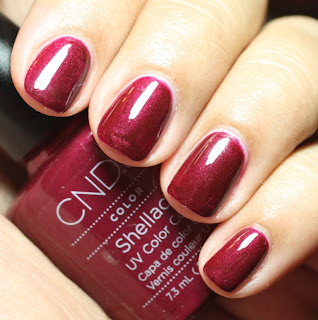I've been thinking that even though this is predominantly a cooking blog, I'd like to do a feature once a week, or once in a while, where I post about something not related to cooking, or mildly related to cooking, or get a guest blogger to post something. I think it's a great idea, but that's me *grin*, what do you think?
Since today is Friday in my part of the world, I thought I'd kick off with this, which is only very mildly (at a stretch) related to cooking, but being the girly-girl that I am, I wanted to talk about it, just 'cos ...
My nails have been starting to look rather grubby with the workout they are getting from all the cooking I've been doing (two dinner parties last week!!). I haven't been happy with them and particularly with all the yuck that gets trapped underneath. I just never seem to be able to keep them looking clean.
To overcome this, I decided that I would color my nails and bought myself some nail polish - base coat, top coat, nail color - the whole works!
I'm pretty good at putting on nail polish well. I stay within the confines of my fingernails and my cuticles and I apply it evenly, etc., - evidence of a youth spent painting my nails a lot. I chose a shimmery nude color, as I did not want to have to deal with color clashes with clothing and make up. Plus, I like the understated look.
After coming home with the haul of nail related paraphernalia, which incidentally is not cheap, I proceeded to clean my nails and apply the polish. The whole process went pretty well except that no matter what I did (and I removed the nail polish and applied using a few different techniques) I got bubbles forming on the polished nail surface. Now, some of my friends tell me it's inevitable and they just ignore it. To me, OCD perfectionist that I am, it's just unacceptable and it bugged the heck out of me.
Since I was unhappy with the results, I went online in search of D-I-Y alternatives that would give me better results - less drying time, no bubbles, long wear, smudge free, etc. All the things that I got out of a pair of gel nails without the bulkiness and weight of the gel nails and found ....
this!
It's a product called "Shellac" by CND that applies like nail polish but has the strength and durability of gel nails, without the thickness and weight. Oh frabjuous joy!
I decided that I liked the sound of it, particularly, after reading a number of forums on the product, as well as some blog reviews. I let my fingers do the walking and googled "shellac" along with my local city and found a place that did it within walking distance of where I lived. Oh more frabjuous joy! Taking a walk on the wild side, I decided to just rock up first thing in the morning instead of making an appointment! Fortunately, they were able to fit me in.
After a short 30 minutes, my nails were done, complete with manicure. The results? Even more frabjuous joy!!! My nails looked lovely and I'm very, very pleased with the results.
On my way out, I accidentally scraped my nail against the metal zipper of my handbag. Verdict? Not a dent, not a scratch! Still in its perfect, just applied condition.
I will be doing this again. Might even get my toes done! They last up to 14 days.
© This work is copyrighted to Invest-Ex and Destiny’s Fortunes Pty Ltd
























